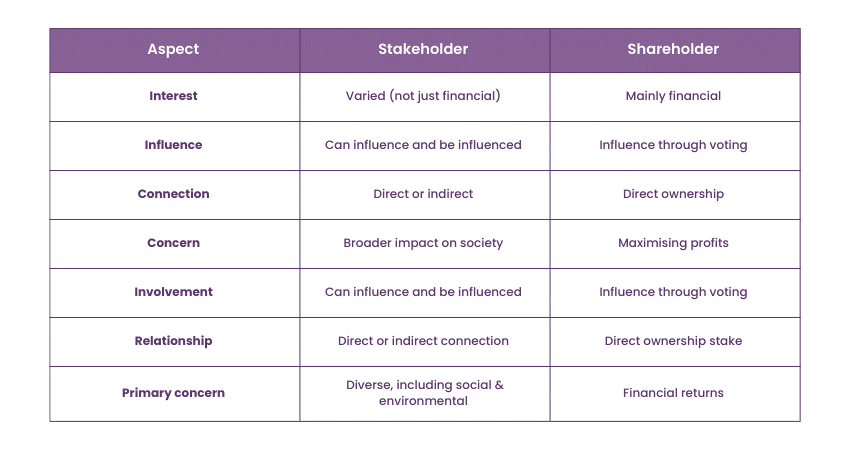We may not have the course you’re looking for. If you enquire or give us a call on +47 80010068 and speak to our training experts, we may still be able to help with your training requirements.
Training Outcomes Within Your Budget!
We ensure quality, budget-alignment, and timely delivery by our expert instructors.

Confused by the recent buzz surrounding Stakeholder Capitalism? Traditionally, businesses have prioritised maximising shareholder profits. But with growing concerns about corporate responsibility, a new approach is emerging. What is Stakeholder Capitalism, and how does it differ from the status quo?
Stakeholder Capitalism proposes a fundamental shift in corporate focus. Instead of solely serving shareholders, businesses broaden their perspective to consider the needs of all stakeholders. This includes employees, customers, suppliers, and even the environment.
By understanding What is Stakeholder Capitalism and its core principles, businesses can create a more sustainable and responsible model, fostering long-term value for everyone involved. This blog dives deep into the philosophy of Stakeholder Capitalism, exploring its potential benefits and the practical steps businesses can take to implement it.
Table of Contents
1) What is Stakeholder Capitalism?
2) History of Stakeholder vs Shareholder Capitalism
3) What Does Stakeholder Capitalism Look Like in Practice?
4) What are the Types of Stakeholders?
5) What do Stakeholders Mean in Economics?
6) What is the Difference Between a Stakeholder and shareholder?
7) Challenges and critiques of Stakeholder Capitalism
8) Conclusion
What is Stakeholder Capitalism?
Let us start with the basic premise of understanding What is Stakeholder Capitalism. Stakeholder Capitalism is an economic philosophy that values the interests and well-being of all stakeholders in a company. You focus on employees, customers, suppliers, local communities, and the environment, not just shareholders. This approach means recognising the broader impact of your actions and striving to balance profit with social and environmental responsibility.
By integrating ethical practices into your operations, you promote a sustainable and inclusive form of capitalism. This philosophy encourages businesses like yours to consider how your decisions affect everyone involved, fostering a more holistic approach to success and growth.
History of Stakeholder vs. Shareholder Capitalism
Shareholder Capitalism emerged in the late 20th century, focusing on maximising shareholder value. It prioritises financial returns for investors above other considerations, driving business decisions aimed at increasing stock prices and dividends.
Stakeholder Capitalism on the other hand has earlier roots but gained prominence in the late 20th and early 21st centuries as a response to the limitations of shareholder capitalism. Stakeholder Capitalism emphasises the interests of all stakeholders—employees, customers, suppliers, communities, and the environment—alongside those of shareholders. This model advocates for balancing profit with social and environmental responsibility, promoting long-term sustainability and inclusivity.
In the early 1900s, business practices were more stakeholder-oriented, focusing on community and employee welfare. Post-1970s, the focus shifted sharply towards shareholder primacy, influenced by economic theories and market pressures. Recently, there has been a resurgence of interest in Stakeholder Capitalism, driven by growing awareness of corporate social responsibility and sustainable business practices.
Prepare for your next interview! Explore essential stakeholder management interview questions and answers now!
What Does Stakeholder Capitalism Look Like in Practice?
Stakeholder Capitalism can be an ideology adopted by company leaders or enforced through government regulations. Companies can demonstrate commitment by:
a) Paying fair wages
b) Reducing the CEO-worker pay ratio
c) Ensuring workplace safety
d) Lobbying for fair tax rates
e) Providing excellent customer service
f) Engaging in honest marketing
g) Investing in local communities
h) Preventing environmental damage
Build an effective stakeholder management plan! Learn the key steps to keep your project on track.
What are the Types of Stakeholders?
There are several types of Stakeholders, and they can be categorised into different groups based on their relationship or involvement. Here are the main types of Stakeholders:

1) Internal Stakeholders: These are individuals or groups within the organisation with a direct interest in its activities, including employees, managers, and shareholders invested in the company's success.
2) External Stakeholders: These individuals or groups outside the organisation can be affected by its actions and include:
a) Customers: People buying and using the company's products or services.
b) Suppliers: Providers of goods or services to the organisation.
c) Investors: Shareholders or bondholders who have invested money in the company.
d) Regulators: Government agencies overseeing the organisation's operations.
Curious about business analyst salaries? Find out the latest data and trends in your region now!
e) Communities: Local communities impacted by the company's activities.
f) Competitors: Other companies in the same industry affected by the organisation's actions.
3) Connected Stakeholders: Stakeholders with a close connection to the organisation but not directly involved in its daily operations, such as trade associations, industry groups, or advocacy organisations.
4) Unorganised Stakeholders: Individuals or groups with an interest in the organisation but not part of any formal structure, including activists, concerned citizens, or informal community groups.
5) Primary Stakeholders: The most critical stakeholders whose well-being and interests are directly tied to the organisation's success or failure, typically including employees, customers, and shareholders.
6) Secondary Stakeholders: Stakeholders whose interests are less direct but still influenced by the organisation's actions, such as suppliers, regulators, or the local community.
Elevate your career with essential business analysis skills with Business Analyst Fundamentals Training - Sign up now!
What do Stakeholders mean in Economics?
A Stakeholder is an individual or entity with a vested interest in a company, where they can influence or be influenced by the company's activities and results. In simpler terms, they hold a stake in the business and its consequences, whether it's a direct or indirect connection.
Unlock the secrets of creating effective Stakeholder engagement with our course on Creating Effective Stakeholder Engagement Training!
What is the Difference Between a Stakeholder and Shareholder?
Shareholders, also known as stockholders, are a subset of Stakeholders. They are individuals or entities that own shares or stocks in a company. Shareholders have a financial interest in the organisation because the value of their investment is directly linked to the company's performance and profitability. They typically have voting rights and may receive dividends.
Stakeholders have a wide range of interests, including financial, social, environmental, and ethical concerns. Their relationship with the company is not solely based on financial investments but includes various interactions and dependencies. Stakeholders may seek to influence the company's decisions and actions to address their respective concerns, which may go beyond financial returns.

Discover how stakeholder analysis can improve project success! Dive into our comprehensive guide.
Challenges and Critiques of Stakeholder Capitalism
Given below are some of the challenges and critiques of Stakeholder Capitalism.
a) Implementation Difficulties: Translating Stakeholder Capitalism into practical strategies is challenging, requiring a balance of diverse and conflicting interests.
b) Accountability and Conflicting Interests: Prioritising multiple stakeholders can obscure accountability and complicate decision-making, potentially affecting efficiency and profitability.
c) Short-term vs. Long-term Focus: Stakeholder Capitalism may encourage short-term decisions to satisfy immediate demands, compromising long-term sustainability.
d) Measurement and Metrics: Measuring success across various stakeholders is complex due to the lack of a universal method.
Master standard deviation calculations and their significance! Learn with real-life examples today.
e) Impact on Shareholders: Prioritising other stakeholders may detract from maximising shareholder value, a traditional business objective.
f) Potential for Greenwashing: Companies might claim stakeholder focus for publicity without meaningful changes.
g) Regulatory and Legal Challenges: Existing legal frameworks may not support Stakeholder Capitalism, complicating implementation without reforms.
h) Lack of Standardisation: The absence of standard guidelines for stakeholder engagement leads to inconsistencies, making assessment challenging for investors and stakeholders.
Clarify stakeholder roles and responsibilities with our easy-to-follow guide. Get started now!
Conclusion
In conclusion, Stakeholder Capitalism rewrites the corporate rulebook, transforming businesses from profit-chasing machines into well-rounded players contributing to a thriving society. By embracing this shift, companies can not only ensure long-term success but also become catalysts for positive change. So, the next time you ask, "What is Stakeholder Capitalism?", remember it's a powerful tool for building a future where businesses and society flourish together.
Unlock the power of business process mapping for a brighter future in business analysis. Join our Business Process Mapping Training today!
Frequently Asked Questions

The four pillars of Stakeholder Capitalism are:
a) People: Focusing on employee well-being, fair wages, and equality
b) Planet: Committing to sustainable and environmentally friendly practices
c) Purpose: Aligning company goals with broader societal needs
d) Profit: Ensuring financial performance while balancing stakeholder interests

Stakeholder Capitalism faces challenges such as balancing diverse interests and potential short-termism. Additionally, issues include implementation difficulties, measurement challenges, impact on shareholder value, risk of greenwashing, regulatory hurdles, and lack of standardisation.

The Knowledge Academy takes global learning to new heights, offering over 30,000 online courses across 490+ locations in 220 countries. This expansive reach ensures accessibility and convenience for learners worldwide.
Alongside our diverse Online Course Catalogue, encompassing 17 major categories, we go the extra mile by providing a plethora of free educational Online Resources like News updates, Blogs, videos, webinars, and interview questions. Tailoring learning experiences further, professionals can maximise value with customisable Course Bundles of TKA.

The Knowledge Academy’s Knowledge Pass, a prepaid voucher, adds another layer of flexibility, allowing course bookings over a 12-month period. Join us on a journey where education knows no bounds.

The Knowledge Academy offers various Business Analyst Courses, including the Certified Business Analyst Professional (CBA-PRO) Course, Business Process Mapping Training and the Business Analyst Fundamentals Training. These courses cater to different skill levels, providing comprehensive insights into Business Process Modeling Techniques.
Our Business Analysis Blogs cover a range of topics related to Stakeholder Capitalism, offering valuable resources, best practices, and industry insights. Whether you are a beginner or looking to advance your Business Analysis skills, The Knowledge Academy's diverse courses and informative blogs have got you covered.
Upcoming Business Analysis Resources Batches & Dates
Date
 Creating Effective Stakeholder Engagement Training
Creating Effective Stakeholder Engagement Training
Thu 1st Jan 1970







 Top Rated Course
Top Rated Course



 If you wish to make any changes to your course, please
If you wish to make any changes to your course, please


